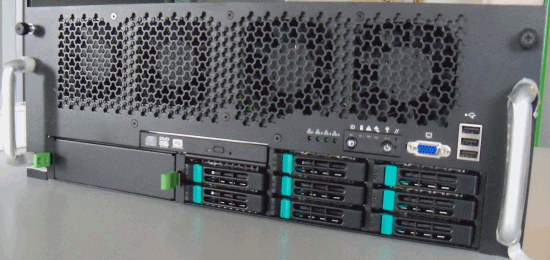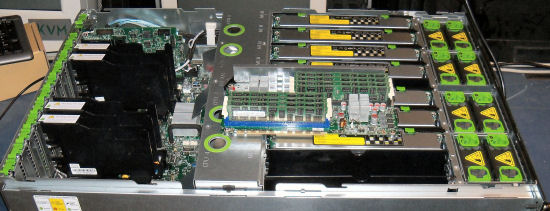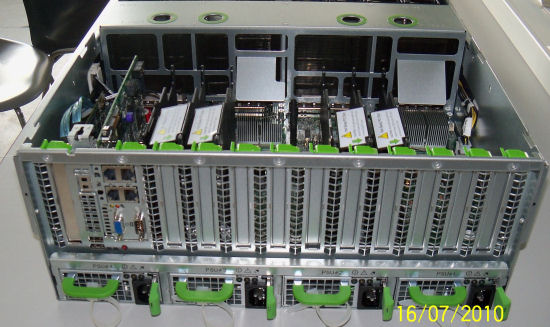Quad Xeon 7500, the Best Virtualized Datacenter Building Block?
by Johan De Gelas on August 10, 2010 5:10 PM EST- Posted in
- IT Computing
The 32-Core, 64-Thread Beast: QSSC-S4R
The heavy—50kg—QSSC-S4R server found its way to our lab. The ODM (Original Design Manufacturer) is the Taiwanese firm Quanta, who designed the server jointly with Intel. The 4U server is equipped for maximum expandability with 10 PCIe slots, quad gigabit Ethernet onboard, and 64 DIMM slots.

The enormous amount of DIMM slots is a result of the use of eight separate memory boards. Each memory board has two memory buffers and eight DIMMs onboard.

A 7+1 hot-swap, redundant fan module setup cools this system down. Notice that the disk system is not in front of the cooling as in most server systems. That is a plus, as the disks should not get the coldest air: disks perform best with medium temperatures (30-40°C, 86-104F) as the lower viscosity of the grease in the rotation motor puts less stress on the rotating components. Google’s study also suggests that disks should be kept at a higher temperature than the rest of the server.
The CPUs and DIMMs however should be kept as cool as possible to reduce the leakage power. The fans are well positioned: the memory boards and the heatsinks of the CPUs right behind them get the coolest air. In the back of the server you find the motherboard. You can see that the heatsinks on the 7500 chipset receive extra airflow.

Four 850W high efficiency power supplies feed this massive machine in a 2+2 or 3+1 configuration. You can find more detailed information about this QSSC-S4R server here. The other benchmarked configurations are identical to this page.










51 Comments
View All Comments
blue_falcon - Tuesday, August 10, 2010 - link
The R715 is an AMD box.webdev511 - Tuesday, August 10, 2010 - link
Yes, and the R715 has 2x AMD Opteron™ 6176SE, 2.3GHz with 12 cores per socket with an approx price of $8,000fic2 - Tuesday, August 10, 2010 - link
4. Part of the Anandtech 13 year anniversary giveaway?!! ;o)mino - Wednesday, August 11, 2010 - link
Big Thanks for that !Etern205 - Tuesday, August 10, 2010 - link
*stares at cpu graph*~Drrroooollllliiiieeeeeeee~~~~
yuhong - Tuesday, August 10, 2010 - link
The incorrect references to Xeon 7200 should be Xeon 7100."Other reasons include the fact that some decision makers never really bothered to read the benchmarks carefully"
You didn't even need to do that. Knowing the difference between NetBurst vs Core 2 vs Nehalem would have made it obvious.
ELC - Tuesday, August 10, 2010 - link
Isn't the price of software licenses a major factor in the choice of optimum server size?webdev511 - Tuesday, August 10, 2010 - link
So does the NUMA barrier.I'd go for less sockets with more cores any day of the week and as a result Intel= second string.
Ratman6161 - Wednesday, August 11, 2010 - link
For the software licensing reasons I mentioned above, there is a distinct advantage to fewer sockets with more cores.davegraham - Wednesday, August 11, 2010 - link
so NUMA is an interesting one. Intel's QPI bus is actually quite good and worth spending some time to get to know.dave